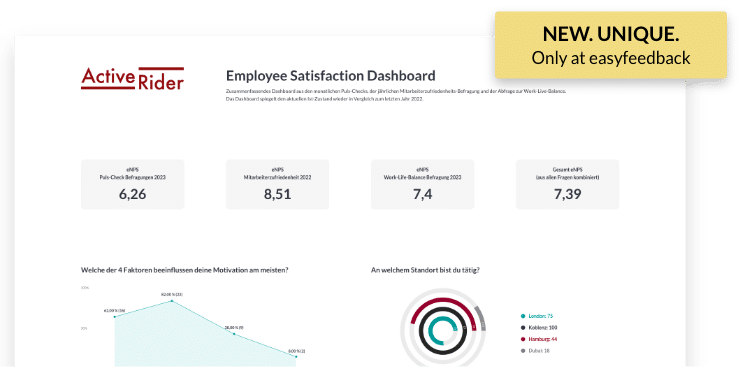Create great customer surveys
Free templates, expert tips & results in real time – with easyfeedback you can create GDPR-compliant customer surveys and gain important insights.
AI assistant ![]() for analyzing and interpreting the results.
for analyzing and interpreting the results.




Customer feedback as a lever for optimization
Use the potential of your own customers to improve business success. Targeted customer surveys provide you with information about customer satisfaction, product preferences, buying habits, and internal processes.
With the help of your customers’ feedback, you can derive future sales, optimize your own product(s), and improve touchpoints with your customers for a longer customer relationship. In addition, you can use regular customer surveys to test marketing goals for effectiveness.
The results obtained from this serve as a starting point for the strategic direction of the company and correction of ongoing measures.
Why you should use customer surveys
When evaluating new products or business ideas as well as existing business models, customer surveys are still the fastest and most valid means of obtaining feedback.
Your customers know you and your product and can give you the best feedback. Through the existing customer relationship, you receive targeted feedback on your business processes or products and can optimize your product in exchange.
But even if you have a new idea, existing customers or a fan community are the best feedback givers.
Gut feeling and internal KPI’s are a good basis for decisions, but only with the feedback of your customers you can substantiate your own ideas and tendencies. It is possible to request only a short feedback after a touchpoint or to determine this as an overall survey with all customers at any time.
Implementation of a customer survey
Why easyfeedback



Flexible survey tool
easyfeedback is a flexible tool that makes it easy to create surveys in the entire CX area. Whether it’s customer satisfaction, needs analyses or NPS surveys – we offer you the ideal solution.
AI-supported evaluation
Automated analysis and interpretation save you valuable time, as there is no need to prepare the results manually.
With just one click, you get an overview of your strengths and weaknesses in a matter of seconds – at overall or customer group level. You also receive specific recommendations for action to improve customer satisfaction.
Do away with external consultants and use the AI-supported analysis from easyfeedback.
German Server & ISO Certification
The protection of your data and trust has the highest priority. The server location is and remains Germany. easyfeedback itself is certified according to TISAX and its service providers according to ISO-27001.
Valid data starts with the right questions
In order to be able to derive measures from the customers’ answers, it is important to ask the right questions in the right context. With ready-made questionnaires, you can create your customized customer survey in no time at all.

Customer Satisfaction
Where are your products better than those of the competition? What are your customers’ wishes? What trends are developing. Find out.

Podcast feedback
Are the topics interesting for listeners? On which platform is the content consumed? How is the target group of listeners defined? This template will give you the answers.

Product Satisfaction
How often do our guests visit us? Which products do they love, which ones don’t? How did our guests find out about us? All these questions and more will give you insight.

Onsite surveys at the touchpoint
Position along the customer experience and learn from touchpoints you define whether your customers and potential customers are satisfied.

Website integration
Flexible use
No need to leave the website
Customer feedback in real time
See how satisfied your customers are in real time. Segment customer groups, satisfaction index, and other metrics to respond to customer needs.

Total or segmented display
Comparative representation
Share reports
Expert knowledge on customer surveys
To help you conduct your customer surveys as effectively as possible, we provide expert knowledge.




easyfeedback Blog - Experience Management
How to use surveys correctly in experience management.

Video instructions
Create, invite and evaluate survey – all explained for you in individual videos.
Almost everything you need to know about customer surveys
What does customer survey mean and what is it used for?
The main purpose of customer surveys is to measure customer satisfaction, customer loyalty and their causes. Customer surveys should ideally be carried out regularly and identify starting points for increasing satisfaction and loyalty. At the same time, the customer survey is also a means of increasing customer satisfaction, since the mere fact that the company inquires about satisfaction increases customer satisfaction.
What methods are available for conducting a customer survey?
The choice of method is extremely important in order to reach your previously defined target group in the best possible way. The goal of the customer survey is what counts. If you have a customer base with an existing email list, it is particularly worthwhile to invite them directly by email to your customer survey. The personal contact is already established and both parties know each other.
You may even be able to address each customer in a personalised way, which will additionally strengthen the bond. There are many examples of customer surveys of this kind – you will certainly know it: “How satisfied were you with your purchase?” or “Please rate your experience with our product”. This method provides you with regular customer feedback, with which new measures can be planned.
If it concerns website visitors, interested parties and potential buyers, embedding the survey in the website is a suitable method. Here, too, the goal of the customer survey is always important. However, with this method it is worthwhile to use a few questions in order to receive quick and concise feedback. “How do you like this article?”. The integration of the customer survey can be done for example via button, feedback tab, popup or focus layer and can thus be seamlessly integrated into your website.
Would you perhaps even like to actively seek personal contact with your customers and exchange ideas with them? Here it is worthwhile to use social media and place the web link there. You can achieve particularly high participation rates via social media, as this is where your company’s “fanbase” often accumulates. Customers who follow you on Facebook, LinkedIn & Co. are most likely to be enthusiastic about your company and want to be part of the development and always up to date.
The bond between your company, product or service and customers who follow you on social media is usually much closer than with customers who don’t. This increases the chances of participating in the customer survey, which gives you more relevant feedback.
However, these are just a few popular of the many methods of conducting a customer survey. Be creative in your choice of method and use the full range. A web link can be placed not only in emails or social media, but also in PDFs. And even a QR code can be used to refer to one of your customer surveys. Ask your customers at all relevant touchpoints for feedback on your experience to provide the best possible customer experience.
How should I evaluate and analyze my customer survey?
The evaluation or analysis of the data for a customer survey is a major hurdle for many people. It is difficult to make a general statement when evaluating the data because the evaluation of the customer survey depends to a large extent on the type of questions and the selected answer format.
Imagine the following scenario: When asked about customer loyalty to your company, the NPS query gives you a value of 52 (on a scale of -100 to 100). According to the benchmarks, this means that you can make a general statement that the customer loyalty in your company is very good. However, what you now lack is the knowledge of which customers are more strongly bound to your company than others. At first you can’t do much with the number 52 and don’t know which areas work particularly well or in which areas improvements are necessary.
But if you know which age groups have a particularly close relationship with your product, service or company and which do not, you can target these groups. This is the point where it becomes interesting and informative within your evaluation. There are various methods of segmenting these into different groups. But what exactly does customer segmentation mean?
In customer segmentation, individual groups are identified from the entirety of (potential) customers, where the individuals within this group have the same characteristics. The assumption here is that these groups usually also show the same (buying) behaviour, but differ significantly in their behaviour from other groups with other characteristics. These can be groups such as new and existing customers, the age or gender of the target group surveyed (demographic segmentation), the place of residence (geographical segmentation) or certain interests. Segmentation strategies can vary greatly for different companies and industries.
Let us assume that you sell surfboards. Geographic segmentation could reveal that people who live near beaches with swell perceive surfboards differently than people who live in a city far from the water. Demographic segments such as women, men and children are also likely to have different preferences when choosing a surfboard.
As you can see, by segmenting your customers when evaluating your customer survey, you can take a much more customer-oriented approach and identify possible optimization potential for specific groups.
Do I need to create a cover letter for each customer survey?
Does a cover letter have to be sent for each survey? The answer to this question is very situation-dependent. However, it is advisable to use a cover letter for some of your customer surveys to introduce the customer to your project thematically first.
It is also advantageous to familiarise him or her with the presumed duration of the customer survey. You should always be honest. If you promise the customer a processing time of one minute and the participant concerned is still on page one of eight after five minutes, then the customer will most likely abandon the customer survey and leave no evaluable feedback.
You should also give your participants a small incentive in your cover letter to participate in your customer survey. This may simply be the prospect of you attaching great importance to the feedback and opinion of your customers and want to constantly improve your offer for them. Many customers are happy about such an undertaking. The mere fact that you want to constantly improve your offer and include the opinion of your customers already increases customer satisfaction.
It is of course also possible to offer a “goodie” in return for customer feedback – this could be a discount for the next purchase, a free additional service or a small gift. However, there are also situations in which a cover letter seems out of place and does not achieve the desired effect. These include, above all, customer surveys where concise feedback is needed.
In these cases, reading the letter would probably take longer than answering the customer survey itself. An example of a type of this type of survey is collecting feedback on an article on your website or the website itself: How do you like this blog article? How do you rate the usability of our website?
Questions like these from the example can usually be answered within seconds and with a star rating and do not require a (detailed) cover letter.
The success of your customer survey is largely determined by the right approach. So think carefully about the purpose for which you want to use your survey and adapt the cover letter to the situation.
How do I create the optimal questionnaire for my customer survey?
In order to design the optimal questionnaire for your customer survey, several factors have to be considered. There is no optimal questionnaire for every case, because every case has different requirements and goals. At this point a very important key point comes into play again: the goal. Never lose sight of this when creating the questionnaire.
Would you like to know how comprehensive or limited your customers’ assessment of the product selection on your website is? Then ask for exactly that. Avoid unclear and imprecise questions at all costs in order to leave no room for interpretation. The longer the participant has to deal with the questions, the higher the probability that sooner or later he or she will stop participating.
In order to design the questionnaire as optimally as possible, also keep the texts and questions to be read as short as possible and concentrate on the essential. For example, explaining a question for too long can lead to it being misunderstood or not understood at all. And to prevent your participants from getting bored, avoid monotonous or uniformly consecutive questions with the same content. In this way you keep the drop-out rates as low as possible. Asking questions is not difficult, but asking good questions is an art.
The length of the questionnaire is one of the most important factors when designing the questionnaire. This should always depend on the degree of customer loyalty or the loyalty to your participants. As a rule of thumb one can say: The higher the loyalty, the more questions can be asked.
If the level of loyalty is low, you should therefore avoid asking more than 10 questions or venturing into complex matrices. The necessary effort – especially with a matrix question – is always underestimated. Put yourself in the participant’s perspective. Would you answer the customer survey under the same conditions? Why should he fill it out and invest his precious time? But always try to keep it as short as possible, regardless of the degree of commitment to your participants. Time is an important factor and the attention of your participants is a gift.
To reduce the drop-out rate even further, it helps to design your customer survey in an appealing way. Does the appearance of the company or the product range come across in the questionnaire? Your own branding can already make a big difference.
Which templates for customer surveys does easyfeedback already offer?
easyfeedback currently offers you the following templates in the area of customer surveys:
• Customer satisfaction
• Product satisfaction
• Identifying customer needs
• Website feedback
• Customer support & service feedback
• Customer cancellation
• Newsletter feedback
• Net Promotor Score
• Customer Effort Score
• Customer Satisfaction Score
• Podcast feedback
• Supplier Survey
• Measure Service Quality
• Feedback Car Dealership
• User Experience Questionnaire
More than a survey tool

Excellent support
You are a professional or you are creating a customer survey for the first time. If you need help, our excellent support is here to help.

Certified IT security
To protect your data, easyfeedback has been certified and only works with certified service providers.

Thousand integrations
Connect to thousands of apps to more efficiently connect your data to other tools in a workflow.


